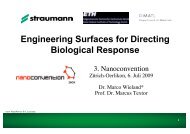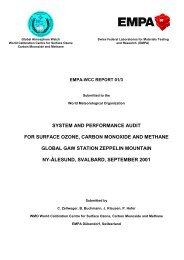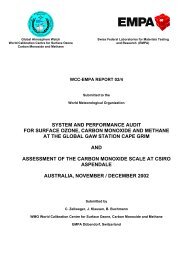GAW - Station Transfer Calibration LAB WCC - Empa
GAW - Station Transfer Calibration LAB WCC - Empa
GAW - Station Transfer Calibration LAB WCC - Empa
Create successful ePaper yourself
Turn your PDF publications into a flip-book with our unique Google optimized e-Paper software.
Field audit regional <strong>GAW</strong> station Jungfraujoch, Switzerland, January 1999 4 / 31<br />
1. Abstract<br />
A system and performance audit was conducted by the World <strong>Calibration</strong> Centre for Surface<br />
Ozone and Carbon Monoxide, at the regional <strong>GAW</strong> Jungfraujoch, Switzerland. Below, the findings,<br />
comments and recommendations are summarised:<br />
Air Inlet System:<br />
All teflon tubes and glass manifolds were clean and free of dust and adequate for trace gas<br />
measurements in particular with regard to minimal loss of ozone. Nevertheless, it is recommended<br />
to rethink the manifold configuration with its many teflon to glass connections, as a preventive<br />
action, in order to avoid possible leakage problems in the future. Although tight at the moment, a<br />
small leak would be very difficult to notice but still can have a significant effect on the results.<br />
Instrumentation:<br />
Ozone Analysers:<br />
The operation of an ozone analyser and a backup instrument (both UV method), considerably<br />
increases confidence in data quality concerning parallel measurements as well as data availability.<br />
Carbon Monoxide Analyser:<br />
The CO NDIR analyser in use is a very stable instrument and adequate to the pollution level of the<br />
site of Jungfraujoch.<br />
Operation and Maintenance:<br />
The appearance inside the station is clean and functional. The room is well equipped with<br />
electronic devices for instrumental control and data acquisition.<br />
The maintenance of the site is clearly structured and organised. The regular calibrations for both<br />
the ozone and CO measurements are regarded as very important means of quality assurance.<br />
Data Handling:<br />
The procedure of data treatment is well organised and clearly arranged. The first reviewing of the<br />
data is done on a regular, mostly daily interval, so that irregularities can be detected early. The<br />
review of the final data set is well done and transparent to the outside, which increases the<br />
reliability of the data.<br />
Documentation:<br />
The documentation of the ozone and CO measurement meets the requirements of the guidelines<br />
for <strong>GAW</strong> stations. It can be taken as a good example for complete and clearly arranged<br />
documentation. However, a practice orientated SOP for maintenance and operation should be<br />
implemented as a preventive action to avoid loss of accumulated knowledge.<br />
Ozone Intercomparisons:<br />
The ozone concentrations observed at the Jungfraujoch (1997) usually ranged between 36 and 67<br />
ppb (5- and 95-percentile of hourly mean values).<br />
The instrument clearly fulfils the assessment criteria as "good" over the tested range up to 100 ppb<br />
(figure 1). Fairly small deviations among the three intercomparisons are the reason for narrow<br />
prediction intervals which implies that the instrument is in good condition.<br />
Carbon Monoxide Intercomparisons:<br />
The results of the CO intercomparison measurements (figure 14) deviate only by about 1 to 3%<br />
from the conventional true value with a measurement uncertainty of approximately 2%. Regarding<br />
the relevant range (99 and 193 ppb, 5- and 95-percentile respectivley) and the methode in<br />
operation this is a very good result.<br />
WMO Global Atmosphere Watch World <strong>Calibration</strong> Centre for Surface Ozone and Carbon Monoxide





